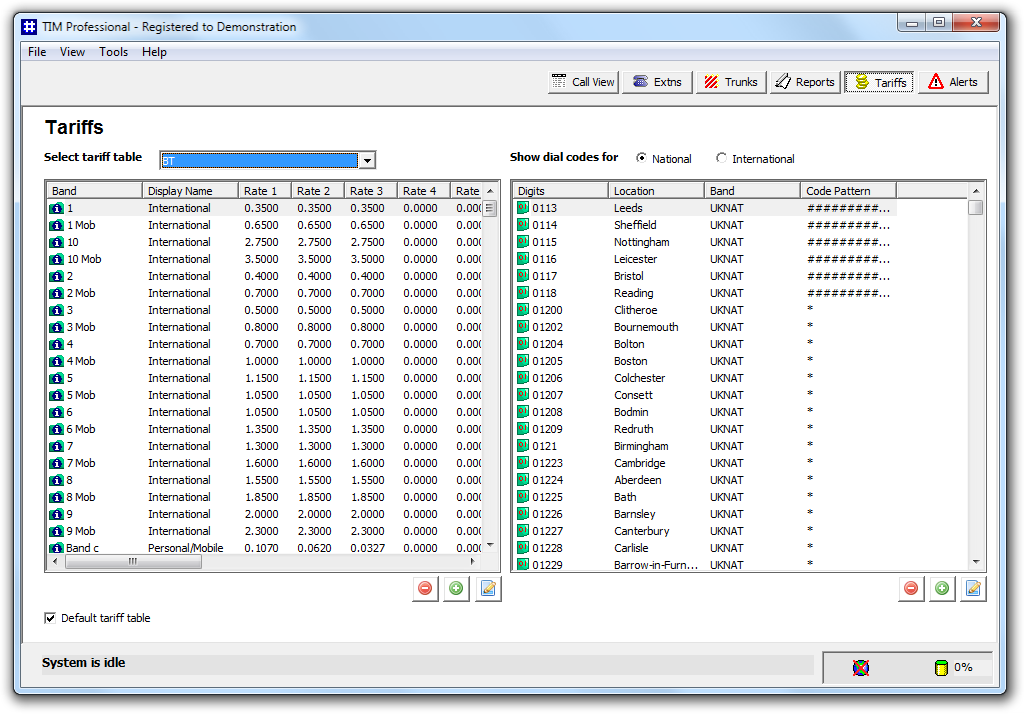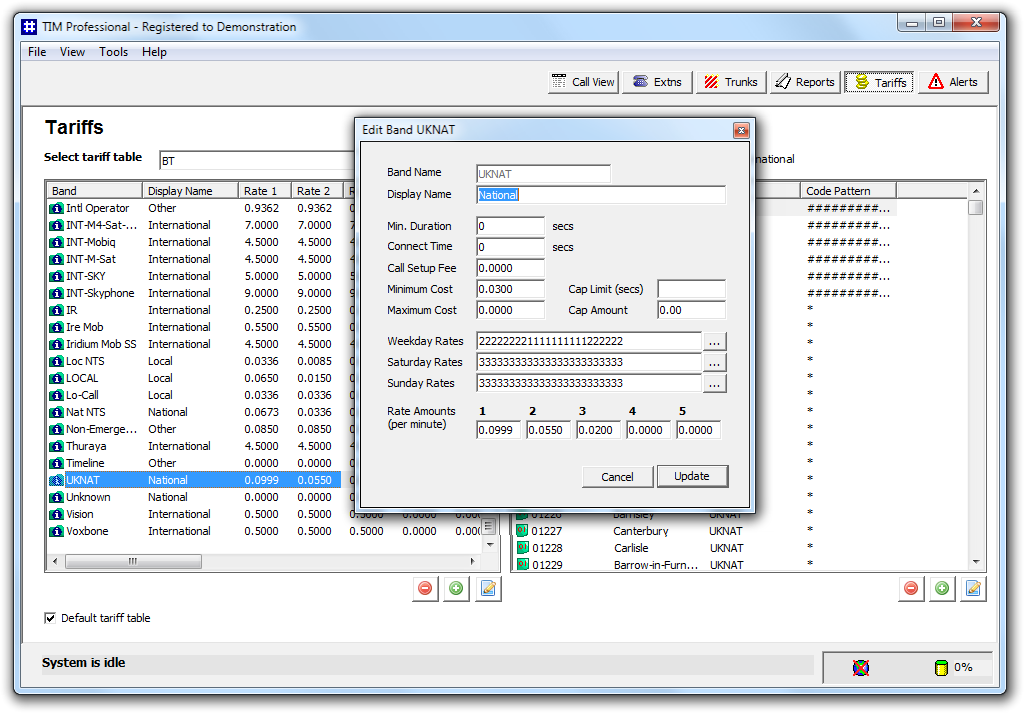To edit a tariff table, select it from the Select tariff table drop-down list at the top-left of the screen. The table will be loaded into the main editing window displaying two panels, as shown below:

Dialling codes
The right panel contains all of the combinations of each valid dialling code for both national and international calls. Select between national and international dialling codes by clicking on the relevant option button in the Show dial codes for group. When selecting between the different dialling codes, the table below it is refreshed to include the new information.
Mobile numbers and other non-geographic numbers appear in the National table.
Each dialling code contains its partial prefix which allows the system to recognise the destination from the original dialled number, a location name, such as London, a band name, and a code pattern. These are explained below.
| Dialling code | Description |
|---|---|
| Digits | Contains the digits necessary to associate a dialled number to the dialling code. When determining the destination and cost of a dialled number, the system takes the first six digits of the number and attempts to locate this in the table. If no match is found, it takes the first five digits, and so on, until the correct match is found. |
| Location | Represents a geographical location name for the dialling code. |
| Band | The name of the tariff band that contains the properties of any call to this type of number, such as cost per minute. |
| Code Pattern | A numeric mask used to validate a number of this type. For example, a London number (020 dialling code) requires a code-pattern of 020########*, which indicats that a London number, in order to be valid, must start with 020 and then be followed by at least eight numbers. If this code pattern is not matched, a call is discarded, as it could have been a number dialled incorrectly. |
Price bands
As described, each dialling code refers to a Price band which contains all of the information needed to cost that call. The best way to describe a price band is to show an example. We'll take a standard price band from the default BT tariff table, UKNAT. This is the standard band for all national-rate calls in the United Kingdom.
Find UKNAT in the band list (left-hand side window). Double-click on it and you should see the window presented below:

| Band fields | Description |
|---|---|
| Min. Duration | Indicates that a call must last for at least x seconds in order to be chargeable. This allows for connection times in the case of old PABX systems, and is a generally accepted figure. |
| Connect Time | This shows the time it normally takes for a call to connect to the specific location, and is subtracted from the actual duration that the PABX reports. It is inherited from old analogue PABX systems that had unreliable connection times, causing clients to be billed for extra time on a call than was actually the case. For modern PABXs, this is not normally an issue and is usually set to 0 now. |
| Call Setup Fee | This allows to enter in any call setup fee that may apply. |
| Minimum Cost | Specifies the minimum cost of a call, regardless of whether the call (at the defined rate for the time it was made) totals less. For example, a 1 minute call at 1p per minute, and a minimum cost of 5p would still total 5p, because 1p * 1 minute = 1p, which is below the minimum cost. |
| Maximum Cost | Used more recently in multimedia and premium rate calls, this specifies that a call can reach no more than the cost specified here, e.g. a 10 minute call at £5.00 per minute, maximum cost £25.00, would only cost £25.00 since it's maximum exceeds the otherwise (10 * 5.00 =) £50.00 cost. |
| Cap Limit (secs) | If there is a maximum duration for particular calls, the duration can be entered here (in seconds). |
| Cap Amount | If there is a maximum charge for a call to a particular number, that capped amount can be entered here. |
| Rate Amounts | These fields specify the rates of calls during weekdays, on Saturdays and on Sundays. The string of numbers is 24 characters long, each character representing its hour in the day, ie. character 1 represents the hour midnight to 1am, character 2 represents 1am to 2am, etc. The digit placeholder for each hour governs the rate at which a call is charged when made during that hour. Eg. 1111111111... means that calls made at any hour of that day will be charged at rate 1. These rates are then defined in their respective boxes, in pence per minute, or equivalent currency. |
| Start Cost | Specifies the starting cost of a call, regardless of how long the duration was. Eg. a starting cost of 50p on a call with a rate of 1p per minute (minimum cost 5p) , lasting 10 minutes, would produce a cost of 50p + (10 * 1) = 60p, the minimum cost already having been exceeded. |
To edit a tariff table, select it from the Select tariff table drop-down list at the top-left of the screen. The table will then be loaded into the main editing window. This editing window is split into two halves, left and right.

The right-hand window contains all of the combinations of each valid dialling code for both national and international calls. Select between national and international dialling codes by clicking on the relevant option button in the Show dial codes for group. When selecting between the different dialling codes, the table below it is refreshed to include the new information.
Mobile numbers and other non-geographic numbers appear in the National table.
Each dialling code contains its partial prefix which allows the system to recognise the destination from the original dialled number, a location name (such as 'London'), a band name, and a code pattern. These are explained below.
| Dialling code | Description |
|---|---|
| Digits | Contains the most significant digits necessary to associate a dialled number to this dialling code. When determining the destination and cost of a dialled number, the system takes the first six digits of the number and attempts to locate it in the table. If it cannot, it takes the first five, and so on, until a match is found. |
| Location | Represents a geographical location name for the dialling code. |
| Band | The name of the tariff band that contains the properties (such as cost per minute) of any call to this type of number. |
| Code Pattern | A numeric mask used to validate a number of this type. For example, a London number (020 dialling code) requires a codepattern of 020########* which indicated that a London number, in order to be valid, must start with 020 and then be followed by at least eight numbers. If this code pattern is not matched, a call is discarded, as it could be the result of a misdial. |